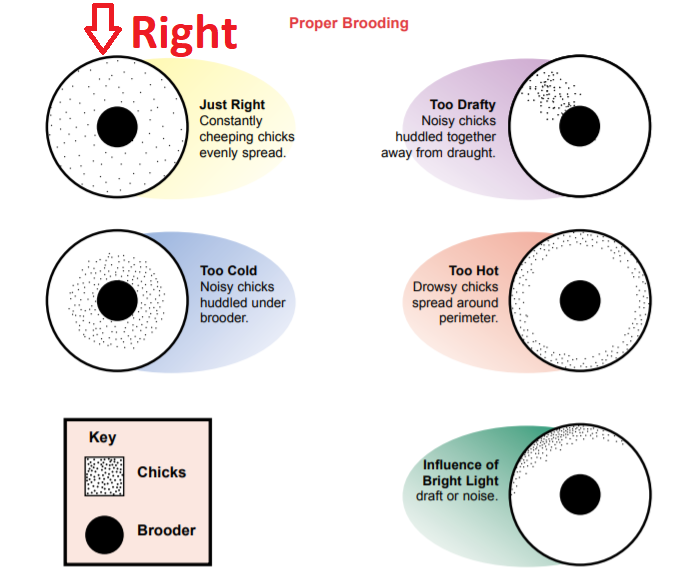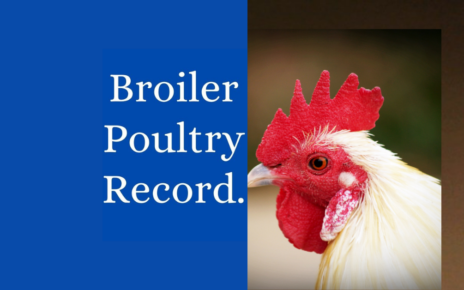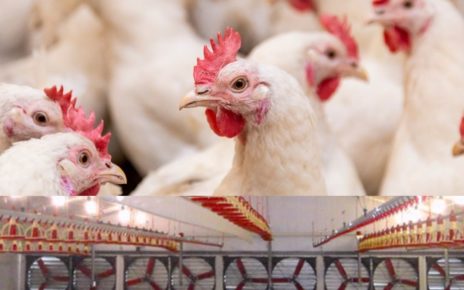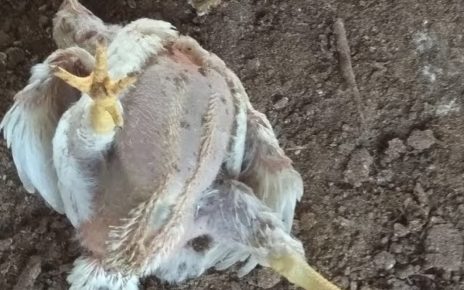Successful broiler poultry farming starts with having a well management program start from pre placement of chicks brooding and the following checklist must be taken care on priority. So always make a checklist & Cross check each & everything before receiving chicks.
In this segment we will cover all important tips of pre placement of chicks and another related important tips of chicks’ management.
Pre-Placement Checklist.
Equipment check– Install the necessary brooding equipment and check that all equipment are functioning properly. Be sure that all Curtains, Cross check all drinkers are in a good position & working properly.
Heater Checks- Verify that all heating systems are installed if using a traditional system, cross check sufficient availability of fuel required if using diesel heaters.
If you are using heaters, every heater should be checked and serviced before receiving chicks.
Preheating Temperature Management in Poultry –
Pre-heating time is dependent on climate conditions, house insulation and heating capacity and will vary from farm to farm. Day old Chicks do not have the ability to regulate body temperature for the first 5 days and self thermo regulation Capacity is not fully developed until 14 days of age.
Day old chicks are highly dependent on the correct litter temperature. If the litter and air temperatures are too cold, internal body temperature will decrease, leading to increased huddling, & feed and water intake will be reduced, which can lead to less growth and susceptibility to disease.
At placement, floor temperatures should be at least 32 °C (95 °F) also required.
As you receive chicks, Temperature must be maintained properly without any fail.
Complete Poultry Training – Link
Thermometer- Always use a thermometer to check temperature. Never judge by yourself. Always check temperature from height of birds & to be checked from many different areas of Brooding area.
It should not be hung very close to the wall or near any heating source.
If favorable temperature is not maintained, extra feed intake without better output, resulting in economic loss.
First 7 Days Temperature must be 90-95 Degree Fahrenheit. If you are not able to keep this temperature at your farm Chicks/Bird will be in stress & stress invite disease. So make sure your bird’s immune system get strong by reducing stress by proper care and management. In the rainy season, wind / air flow is high & it can reduce the temperature resulting huge mortality.
Proper management must be given to control strong wind to maintain temperature & good Curtain management. Keep the curtain of poultry farm Very Tight like, to avoid any failure. If Curtain failure either by accidentally done it can cause big damage to your Profit.
Round brooding– Before the chicks arrive, prepare a round brooding area
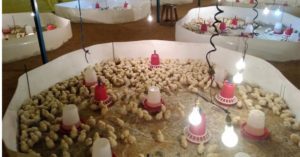
surrounded by a cardboard fence approximately 16 inches high and 6 feet in diameter.
News Papers or papers -Several thicknesses of newspaper placed under the waterers and feeders for the first week helps keep the contents clean.
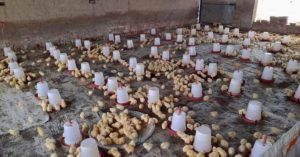
It also doesn’t allow chick to eat litter’s content.
List out Brooder house accessories:-
Some Poultry farmers use Infrared lamps as a convenient heat source in a brooder house. One 250 watt infrared lamp is usually sufficient to heat 100 chicks at an average temperature of 95°F.
You should always use more than one lamp so the chicks will not be without heat if a lamp burns out accidentally.
Small brooders with an electric heating element can be purchased for brooding small numbers of chicks.
Personally monitor the distribution of the chicks closely especially during the first days to day seven or appoint a good manager with high experience.
Always Notice Chicks Behavior. Right Position is First Position.
Check chicks after one-2 hours placement. If chicks start panting they can lose 5-10 g of moisture in the first 24 hours and then dehydration will occur.
Higher relative humidity will reduce moisture loss but also impair heat loss, so correct temperature is required.
Also Consider Chicks from smaller eggs (Chicks came from younger breeder flocks) require 1 degree higher brooding temperature.
Always emphasize to minimize temperature fluctuations, especially at night. Better temperature control will improve feed conversion and enhance growth rate.
Drinker Cross check-
Ensure all drinkers should be well sanitized, clean & free from dirt.
If you use a nipple system Adjust pressure to produce a droplet of water visible on each nipple without dripping.
Check for water leaks and air locks.
Ensure that nipple drinkers are at the level of chicks’ Eye.
Water must be clean and fresh to ensure the water tank is clean & well sanitized.
Heating system at poultry farm.
The main purpose of Heating is to maintain Best temperature as per requirement of age of birds.
The key to maximizing bird performance is providing a consistent housing environment a consistent & floor temperature for birds.
You can maintain temperature by any method. Whatever suits you in an economical way. Either is traditional or modern way.
House Preparation-
Partial house brooding is commonly practiced in an attempt to reduce heating costs.
By reducing the amount of space dedicated to brooding, one can conserve the amount of heat required and reduce energy costs. In addition to maintaining the correct temperatures is more easily maintained in a small area.
The Other benefit is in winter or rainy season, when there are unwanted gases in Poultry Farm, You can provide fresh air from the Inner Part of available space by heating that properly. It allows not to decrease the temperature immediately.
For making Round shaped support, you may use fiber sheets & Iron sheets,
But Iron sheets make huge noise while using it and are heavy in weight.
Impact of Rust may cause damage.
So Fibre sheets are preferred of around 1.5 feet to 2 feet is considered Good.
But remember prior to opening, while providing space the new unused brooding needs to be heated and ventilated to the desired bird requirement of temperature & Free from any smell of disinfectant before releasing birds into the new area.
Relative Humidity.( RH )
First Try to Understand what is Humidity? Then we will move ahead to understand Effect on performance on Poultry.
Easily stated humidity is simply the amount of water vapor held in the air. Water vapor is the gaseous stage of water.
There are three main measurements of humidity: relative, absolute and specific.
Related Humidity levels in the first 3 days after placement should be around 60%.Chicks kept at the correct humidity levels are less prone to dehydration and generally make a better, more uniform start.
Humidity, however, hardly influenced the behaviour of day old chicks. High relative humidity decreased the effectiveness of panting.
RH within the broiler house should be monitored daily using a hygrometer. If it falls below 40- 50% in the first week, the environment will be dry and dusty. The chicks will begin to dehydrate and be predisposed to respiratory disorders.
Mini Drinkers Cross check-
Must not be allowed to dry out.
Must be cleaned properly minimum one time a day & ensure water must be available always without any fault.
Maintain maximum water levels until chicks are large enough to create spillage. Because some Poultry Farmers wait till finish of water, but birds can through the drinkers while drinking, playing or running & small quantities of water available can make spillage.
Always place drinkers slightly higher than litter to maintain water quality yet not so high that access is impeded.
If using Bell drinkers than Cross check important Points are-
Height should be maintained such that the lip is at the level of the birds’ back.
Regularly make assessments and adjust the level on a regular interval.
Must be cleaned daily to prevent build-up of contaminants.
If necessary, in Summer or hot climates, flush water system at least twice/Thrice daily to maintain a good water temperature by not allowing, enter hot water for Poultry Birds.
All bell drinkers should be adjusted properly to reduce spillage.
If you are Using Nipple system than following Points Must Be taken Care-
Height should be at chicks’ eye level for the first 2 days of age and then maintained slightly above chicks’ head.
Pressure should be such that there is a droplet of water suspended from the nipple but no leakage.
The birds’ feet should always be flat on the litter and a bird should never have to stand on its toes to drink. Flush the lines as required.
Cross check of Effective management
Cross check of Effective management after around 2 Hour after placing Chicks.
Take a random Sample around 50 chicks per brood area.
& Touch the feet of Chicks. If the feet are cold, re-evaluate your heating system•
One More Blunder by many Poultry farmers Results of Cold Litter:
If the chick’s feet are cold, the internal body temperature of the chick will also be reduced. Cold chicks will be seen huddling with reduced activity and resulting in reduced feed and water intake and therefore reduced growth rate.
Place the feet of Chicks with your cheek one can readily learn how warm or cold the chick is.
If they are comfortably warm, the chicks should be actively moving around the brooding area.
Number of Feeders and Drinkers- around 3 feeders and drinkers usually required, one Nipple is sufficient for 10 chicks. But you can increases the amount of feeders and drinkers for baby chicks it give comforts to chicks because of very easy availability of feed and water.
Feed- Ensure availability of Crumbs feed in advance is preferred for better results.
Water-Ensure water temperature must not very high or very low and must be very clean from contamination and other impurities. Keep Jaagery or Sugar ready at your poultry farm.
